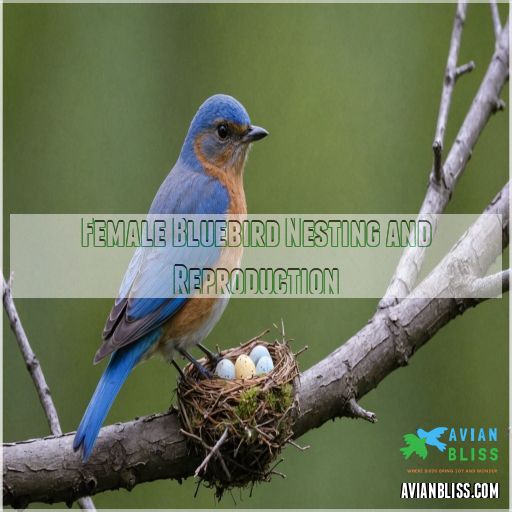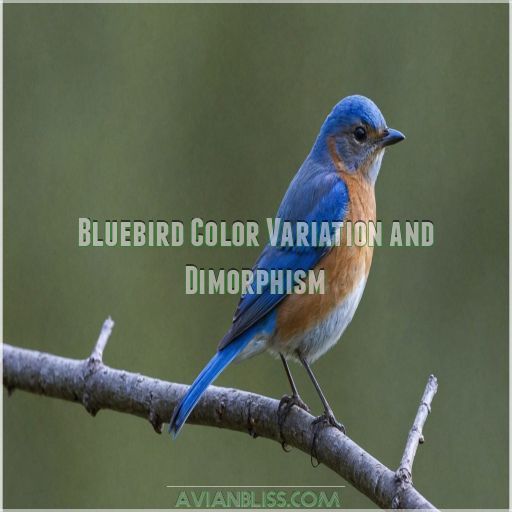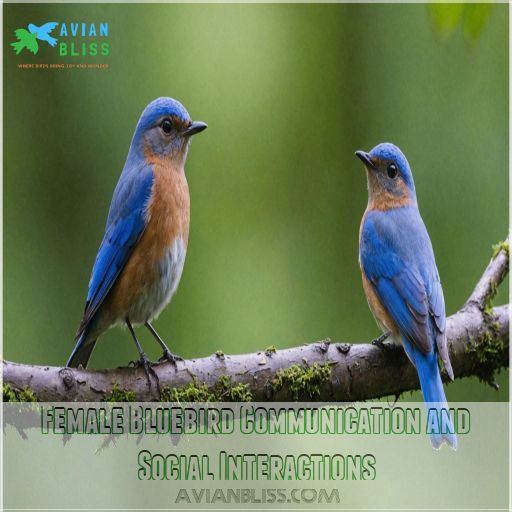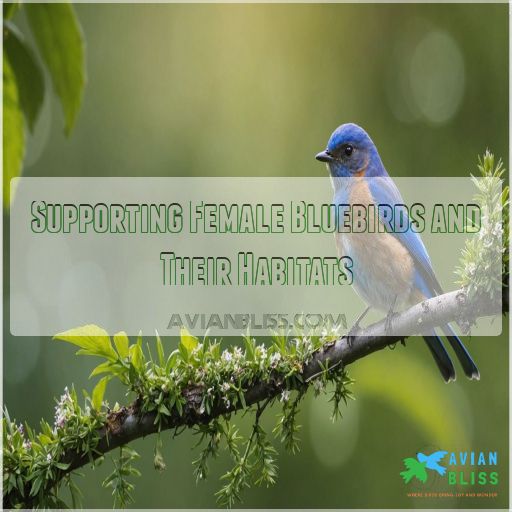This site is supported by our readers. We may earn a commission, at no cost to you, if you purchase through links.

Her wings and tail still flash some blue, though, giving her a touch of pizzazz.
As for nesting, she’s the real MVP, building cozy homes and incubating eggs like a pro. These ladies are the unsung heroes of the bluebird world, balancing motherhood with territorial defense.
And here’s a juicy tidbit: some female bluebirds have a wild side, engaging in secret trysts during breeding season.
Table Of Contents
- Key Takeaways
- Identifying Female Bluebirds
- Female Bluebird Behavior
- Female Bluebird Nesting and Reproduction
- Female Bluebird Egg Characteristics
- Female Bluebird Diet and Nutrition
- Female Bluebird Lifespan and Interesting Facts
- Bluebird Color Variation and Dimorphism
- Female Bluebird Roles and Responsibilities
- Female Bluebird Communication and Social Interactions
- Supporting Female Bluebirds and Their Habitats
- Frequently Asked Questions (FAQs)
- How do you know if a bluebird is male or female?
- How do you identify a female eastern bluebird?
- What is the difference between a male and female eastern bluebird?
- What is the difference between male and female mountain bluebirds?
- How to tell a male bluebird from a female?
- What color are female bluebirds?
- Does the male or female bluebird make the nest?
- Do female bluebirds stay in the nest?
- How do female bluebirds respond to nest intrusions?
- Do female bluebirds return to the same nesting site?
- Can female bluebirds raise broods without a mate?
- How do female bluebirds select their mates?
- What threatens female bluebirds during nesting season?
- Conclusion
Key Takeaways
- You’ll spot female bluebirds by their subtle beauty – they’re rocking grayish-blue plumage on top with a dull copper-brown chest, nature’s way of helping them blend in. Think of them as the understated fashionistas of the bird world!
- When it comes to nesting, these ladies are the real MVPs. They’re not just pretty faces – they’re skilled architects, building cozy homes and incubating eggs like pros. It’s like they’ve got a Ph.D. in "Bluebird Home Economics"!
- Don’t let their demure appearance fool you – female bluebirds can be fierce defenders of their territory. They’ll swoop and click their beaks at perceived threats, even at humans. It’s like watching a tiny, feathered superhero in action!
- You can support these hardworking moms by setting up proper nesting boxes and offering mealworms as treats. Just remember, while mealworms are like bird candy, they shouldn’t be the main course during breeding season. You’re essentially running a bird B&B – provide the right amenities, and they’ll keep coming back!
Identifying Female Bluebirds
Wondering how to identify female Eastern Bluebirds? Look for their distinctive gray-blue plumage and warm brown breasts – a bit duller than their male counterparts.
Nestling females have lighter gray wings and tail feathers compared to the bright blue of the males, making their male counterparts‘ characteristics a useful reference for comparison.
Key Physical Characteristics
Spotting an Eastern Bluebird is like finding a hidden gem.
Female bluebirds showcase pale blue wings and gray-blue tails, giving a softer touch compared to their male counterparts. Their beaks, perfect for insect hunting, are small and straight.
These lovely creatures add charm to gardens, often found near nest boxes, embodying grace and subtlety in nature.
Differences in Plumage Between Female and Male
You’re wondering how to spot those gender differences in bluebirds.
Male bluebirds showcase vibrant blues and fiery brick-red accents, practically a peacock’s cousin. Meanwhile, females opt for subtlety—a mix of grayish-blue with warmer brown hues.
It’s all about sexual dimorphism: males flaunt for mates, and females blend into nature’s canvas, mingling beauty and practicality , showcasing a unique example of mingling beauty and practicality.
Nestling Female Bluebird Identification
Determining a nestling bluebird’s gender is like solving nature’s little mystery. At around 13 days old, look closely at their wing feathers.
Females have paler colors and subtle spotting patterns compared to the vibrant males (Source).
Understanding these distinctions in their breeding season helps with effective parental care.
It prevents nest parasitism in their nesting territory.
Female Bluebird Behavior
When you spot a female bluebird, you might be charmed by her subtle communication and fascinating mating habits.
Her territorial and aggressive behaviors, though fierce, show that even the shyest birds can defend their home like a feathered warrior, illustrating the bird as a feathered warrior.
Communication Styles
Exploring the lives of female bluebirds, you’ll discover they’re quite the communicators!
They use vocalizations and nesting calls to share important info, such as predator warnings or mate communication .
These chirpy ladies even engage in territorial defense and express predation risk, reminding us communication isn’t just for tree frogs.
Nature’s own social network, indeed!
Mating Habits and Monogamous Relationships
Unravel the intriguing love life of female bluebirds during the breeding season.
They often engage in extra-pair copulation, mixing adventure and romance like a reality TV show.
Despite potential liaisons, many exhibit lifelong monogamy.
Mate selection hinges on nesting success and territorial defense, ensuring strong partnerships amidst challenges—akin to tree frogs croaking persistently in love’s wilderness.
Territorial Behavior and Aggression
As a female bluebird, you’re no stranger to territorial disputes.
When defending your nest, you’ll aggressively swoop and click your beak at any perceived threats, even humans . This assertive behavior guarantees your young stay safe from predators and competitors.
Your mate may not share your feisty nature, so work together to safeguard your territory (Source).
Female Bluebird Nesting and Reproduction
If you’ve ever wondered what it takes for female bluebirds to raise their young, it’s quite the operation involving everything from nest crafting to strategic egg care.
These diligent moms handle most of the nest building and incubating duties, sometimes even with the help of another female in fascinating cooperative breeding arrangements.
They prove that teamwork really makes the dream work in birdland.
Nest Building and Materials
When building nests, female bluebirds showcase their eye for detail by weaving grasses and pine needles into a cozy abode.
They’ll sometimes add horse hair or feathers for flair.
Their charming nests often nestle in open spots with sparse cover, perfect for home sweet home.
Don’t be surprised if males lend a hand, or talon, too, to help with their eye for detail.
Incubation Period and Egg Care
Bluebirds, with their charming antics, typically lay one egg each morning until the clutch is complete, often consisting of four to five eggs.
Only the female incubates, starting as soon as the last egg is laid, for about 13.5 days on average.
These eggs, while mostly blue, can occasionally surprise with white hues, showing that the eggs are not always mostly blue .
Cooperative Breeding Systems and Extra-Pair Copulation
Female bluebirds often use clever mating strategies, like extra-pair copulations, to spice up their social dynamics and enhance offspring fitness through genetic diversity.
They invest wisely in these strategies, balancing risks and rewards:
- Genetic Diversity: Enhances survival chances.
- Social Dynamics: Engages community roles.
- Parental Investment: Shared by cooperative groups.
This dance helps create resilient generations.
Female Bluebird Egg Characteristics
Regarding laying eggs, female bluebirds add a splash of color to their nests with typical blue-green eggs, but don’t be surprised if you find exceptions in white or pink hues.
They’re fiercely protective, ensuring their avian offspring stay safe from nosy neighbors and sneaky predators.
Occasionally, they even practice a little neighborly egg-sharing mischief known as egg dumping, which could also be viewed as a form of the birds being fiercely protective and engaging in the natural process of laying eggs.
Egg Color and Variations
You’re in for a treat on the egg color spectrum!
Female bluebirds usually lay enchanting light blue eggs, reminiscent of a soft spring sky, forming 97% of clutches.
However, curiosities abound: 2-5% of their eggs may appear white or pinkish—a quirk of nature’s palette, suggesting genetic twists or occasional health wobbles in the female, a result of nature’s palette .
Laying Eggs in Other Nests
Occasionally, female bluebirds may lay their eggs in the nests of other bluebirds, a behavior known as "egg dumping" or "nest parasitism" .
While this can provide evolutionary benefits, it also means the host parents must care for the extra chicks, which can be a significant burden.
Staying vigilant and removing any suspicious eggs is essential to protect your bluebird family, as this helps to prevent "a significant burden".
Defending the Nest From Predators
While bluebirds occasionally lay eggs in other nests, protecting their own is a high-stakes game of survival, especially for birds like the Dusky Thrush that lay their blue eggs in forests across Asia. Dusky Thrush
.
These vigilant birds exhibit defensive behaviors like mobbing predators to safeguard their nest site.
It’s like having a well-organized security team, ensuring predator awareness is excellent to boost nesting success rates. Who knew bluebirds were such savvy strategists?
Female Bluebird Diet and Nutrition
Among female bluebirds, their diet’s a mix of insects and berries, with a penchant for protein-packed bites like beetles and spiders.
Just remember, while mealworms make a tasty treat, they’re not the best choice during breeding season if you want the chicks to have a varied menu.
Primary Food Sources
Ah, the female bluebird, dining in style!
She’s got a taste for independence with a diet rich in:
- Insects: Think beetles and caterpillars for the main course.
- Spiders: Adds a bit of crunchy texture.
- Fruits: Seasonal berries make for a delightful dessert.
- Seeds: A backup for lean seasons.
Sadly, human impact can alter food availability, affecting nestling diets.
Mealworms and Breeding Season Considerations
When you’re feeding bluebirds during the breeding season, mealworms are a top choice to supplement their diet. They’re like nature’s little snack packs, fueling chick health and supporting breeding success.
But don’t put all your eggs in one basket—consider mealworm alternatives to make sure diet diversity and meet their nutritional needs.
| Mealworms | Waxworms | Superworms | Suet |
|---|---|---|---|
| Protein-rich, affordable | High in fat, pricier | Handle with care | Winter favorite |
Importance of Insects and Berries
Insects and berries are the dynamic duo of a female bluebird’s diet, offering strength and vitality. During warm months, insects dominate, providing protein and energy. As insects retreat with the chill, juicy berries step up as the gourmet choice, bringing essential nutrients.
- High protein from insects
- Nutrition-packed berries
- Seasonal food shifts
- Important for survival
That’s one delicious cycle!
Female Bluebird Lifespan and Interesting Facts
You’re about to discover fascinating insights into the female bluebird’s lifespan and unique quirks that make them a delight to observe.
With their vibrant plumage and migratory habits, these birds are as resilient as they’re beautiful.
They dart between their cozy nests and southern skies.
Average Lifespan and Factors Affecting Longevity
The average lifespan of a female bluebird is around 5 years, but some can live up to 10 years.
Factors like predator impact, habitat loss, disease risk, food scarcity, and climate change can greatly affect their longevity.
With proper nesting conditions and protection, female bluebirds can thrive and grace our skies for years to come.
Unique Characteristics and Distinct Plumage
Female bluebirds don’t flaunt vibrant colors like their male counterparts.
Their subtle blue-gray plumage, with hints of brown and white, serves as nature’s camouflage strategy, a clever trick in the wild game of hide-and-seek with predators.
This dimorphism isn’t just stylish; it plays a key role in bluebird identification and their evolution , blending beauty and practicality effortlessly.
Migratory Patterns and Cavity Nesting
You might find female bluebirds engaging in their migratory dance, venturing south for winter survival—a move essential for those living in northern areas.
Their choice of cozy cavity nests is noteworthy, as they skillfully deal with competition by selecting nest boxes designed for security and comfort .
Their knack for timing and habitat selection is simply exquisite!
Bluebird Color Variation and Dimorphism
When you’re spotting bluebirds, it’s fascinating to observe how female bluebirds exhibit subtle yet beautiful color variations.
Their plumage isn’t just about looking good; it’s a brilliantly adapted feature reflecting their seasonal and geographic behaviors.
Seasonal Color Changes
When seasons shift, bluebird colors get a wardrobe change! During the breeding season, they dazzle with vibrant colors, while winter tones turn subtler.
Their molting aligns with the seasons, creating these plumage variations.
Think of it as nature’s way of ensuring they’re dressed for success, whether impressing mates or blending into winter’s quieter landscape, which is nature’s way.
Geographic Color Variation
In a world where evolution meets style, bluebird color variation dances to the tune of regional adaptations.
Environmental factors and genetic influence create unique hues across habitats, from cyan to deeper blues.
Evolutionary trends suggest each shade tells a story of survival and allure.
So next time you’re birdwatching, wink at nature’s artistry, where every feather’s a masterpiece.
Female Bluebird Roles and Responsibilities
As a champion of multitasking, the female bluebird handles everything from nest construction to defending her territory with fierce dedication.
You’ll find her building and maintaining a cozy home but also expertly brooding and feeding her young, all while keeping a vigilant eye out for pesky predators.
As a result, she is quite skilled at nest construction, which is an integral part of her multitasking.
Nest Construction and Maintenance
As a female bluebird, you take great pride in constructing the perfect nest.
You carefully gather a variety of materials like grass, moss, and feathers to create a cozy, well-insulated home .
Maintaining the nest is an ongoing task, as you regularly repair any damage and keep it clean to protect your future hatchlings (Source).
Brooding and Feeding Young
Building a snug nest is just the beginning.
Female bluebirds brood their young diligently, ensuring warmth for about 12-14 days . These chicks, ready for freedom, grow rapidly, fueled by frequent feeds.
Both parents share feeding duties, delivering insects and berries to nestlings, creating a nurturing environment that fosters a strong family dynamic.
Just imagine the lively chirps echoing, signaling feeding time!
Territorial Defense and Predator Avoidance
Among the female bluebirds’ numerous skills, their nest defense strategies are something to squawk about.
They’ve mastered predator recognition, using alarm calls like feathered noisemakers to rally the troops.
With mobbing behavior that could give a rock band a run for their money, they fiercely protect their territory boundaries.
It’s a bird-eat-bird world, after all!
Female Bluebird Communication and Social Interactions
When you hear the soft "tu-a-wee" call of a female bluebird, she’s likely chatting with her mate or warning of a predator nearby.
These sociable birds are all about teamwork, occasionally accepting an extra helper and forming bonds that involve both fierce nest defense and gentle caregiving.
Vocalizations and Call Patterns
You’d be amazed how female bluebirds use call variations for mate communication and alarm calls.
Like a maestro with seasonal changes in mind, they orchestrate sounds that include soft chirps for familial chatter to sharper tones for territorial defense.
It’s like having a walkie-talkie in nature’s concert, with each note holding power and purpose, in a way that can be considered a "nature’s concert" – an orchestration of sounds that convey specific messages – with each note a form of territorial defense !
Visual Displays and Aggressive Behavior
Aggression in female bluebirds might surprise you with its intensity and purpose. It’s all about maintaining freedom and power in their world.
- Threat Displays: With fierce postures, they assert boundaries, ensuring rivals think twice before crossing them .
- Territorial Defense: To guard nests from intruders, female bluebirds can become warriors in feathers .
- Courtship Rituals: A mix of aggression and allure keeps potential mates on their toes .
Cooperative Breeding and Social Bonding
Just like a juggling act, female bluebirds balance mates and youngsters with ease. Their social bonds don’t just stop at flashy displays; they’re all about cooperative breeding and nest-sharing dynamics. You might think raising young is a solo gig, but helpers jump in, sharing duties and enriching social hierarchy.
| Role | Interaction Type |
|---|---|
| Parent | Nurturing |
| Offspring | Sibling rivalry |
| Helpers | Nest-sharing dynamics |
| Male Partners | Mating strategies |
These bluebirds sure know teamwork!
Supporting Female Bluebirds and Their Habitats
Providing the right habitat and resources is key to supporting female bluebirds.
From setting up nesting boxes to offering food and water, you can make a real difference in their survival and success.
Providing Nesting Boxes and Suitable Habitats
Transform your backyard into a bluebird paradise by installing a well-crafted bluebird nesting habitat
.
Make sure it’s designed with proper ventilation and predator control features, like overhanging roofs and drainage holes.
Safe nesting habitats invite bluebird families to settle, and it’s a fulfilling way to support bluebird conservation while enjoying their vibrant colors and cheerful presence in your own sanctuary, often near mountain bluebird nests mountain bluebird nest
.
Offering Food Sources and Water
Creating a bluebird-friendly haven in your yard can be a joy.
Offering mealworms and installing a bird bath with moving water are great ways to attract them.
Watch them feistily flutter about, grateful for the bounty.
Remember, these bright beauties favor live food, so keep those mealworms lively for their dining pleasure, making them a great source of moving water.
Minimizing Predation and Human Disturbance
Supporting female bluebirds means keeping them safe from predators and human disturbances.
Prioritize:
- Predator-safe nesting: Use cone or stovepipe baffles to protect nests from raccoons and snakes .
- Habitat protection: Keep nest boxes away from busy areas.
- Disturbance avoidance: Limit frequent visits near nesting sites.
- Nest box placement: Position boxes at least 6 feet above ground, considering ideal eastern bluebird habitats
.
Frequently Asked Questions (FAQs)
How do you know if a bluebird is male or female?
Like a painter’s palette, bluebirds reveal their gender through color.
You’ll spot males by their vibrant blue backs and rusty breasts, while females sport muted gray-blue hues with subdued orange tones.
Look closely—nature’s artistry awaits!
How do you identify a female eastern bluebird?
You’ll spot a female eastern bluebird by her subdued colors, which are different from the bright blue males. Learn more about the Eastern Bluebird’s appearance
.
Look for a grayish-blue back, warm brown throat and breast, and white belly.
Her wings and tail will have a subtle blue tint.
Watch for wing-waving courtship displays too!
What is the difference between a male and female eastern bluebird?
A splash of blue against the sky, nature’s artistry unfolds.
You’ll spot the difference in their plumage: males dazzle with vibrant blue backs and rusty breasts, while females sport subdued gray-blue hues with softer orange tones.
What is the difference between male and female mountain bluebirds?
Male mountain bluebirds dazzle with brilliant turquoise plumage all over, while females sport a more subdued look.
You’ll spot grayish-brown bodies on the ladies, with blue wingtips and tail feathers adding a subtle pop of color .
How to tell a male bluebird from a female?
Did you know that 23 million Eastern Bluebirds grace our skies?
To spot the difference, look for vibrant hues. Males flaunt deep blue backs and rusty breasts, while females sport subdued gray-blue tops with muted orange chests.
It’s nature’s fashion show!
What color are female bluebirds?
Female bluebirds sport a more subdued palette than their flashy male counterparts.
You’ll notice their grayish-blue wings and tail, with warm brown breast feathers.
It’s like they’re wearing a chic, earthy outfit for blending in while nesting.
Does the male or female bluebird make the nest?
While both partners contribute, the female takes charge of nest construction.
You’ll see her busy weaving grass and pine needles into a cozy cup, with the male occasionally pitching in materials.
It’s a labor of love!
Do female bluebirds stay in the nest?
You’ll find that these dedicated moms don’t lounge in the nest.
They’re busy incubating eggs for 12-14 days, then feeding chicks for 16-22 days before fledging.
It’s a real labor of love!
How do female bluebirds respond to nest intrusions?
Like a mother bear protecting her cubs, they fiercely defend their nests.
You’ll see them scolding intruders, performing aggressive flights, and even physically attacking threats.
They’ll spend up to 80% of their time on nest defense when necessary.
Do female bluebirds return to the same nesting site?
Female bluebirds often return to the same nesting site year after year, showcasing remarkable nest site fidelity .
This loyalty allows them to reclaim familiar territory and build upon previous successes.
You’ll likely see these feathered homeowners back in action, showcasing their remarkable nesting site skills!
Can female bluebirds raise broods without a mate?
Raising a brood solo isn’t easy, but it’s possible.
While males typically help feed and protect, determined females can go it alone.
They’ll work overtime, incubating eggs and hustling for food to keep those hungry beaks fed with the mother doing all the work essentially going it alone.
How do female bluebirds select their mates?
Did you know 95% of bluebirds mate for life? You’ll find these feathered romantics aren’t just about looks.
They’re savvy daters, considering territory quality and nest sites.
Ladies, you’ve got the power – you’ll initiate courtship with a flirty wing shake!
What threatens female bluebirds during nesting season?
During nesting season, you’ll face threats from predators like house sparrows, which can destroy eggs and harm chicks.
Watch out for wet nests, parasitic cowbirds, and even nestlings struggling to fledge .
Stay vigilant to protect your feathered family!
Conclusion
Did you know that female bluebirds lay an average of 4-5 eggs per clutch? These resilient mothers are the backbone of bluebird populations.
By understanding female bluebird traits, you’re better equipped to support these charming birds. Whether you’re providing nesting boxes, offering mealworms, or simply admiring their subdued beauty, remember that these ladies are nature’s unsung heroes.
So next time you spot a grayish-blue beauty flitting about, give her a nod of appreciation. She’s working hard to keep the bluebird world thriving, making her a vital part of the ecosystem, and definitely worth a moment of appreciation.













